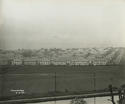 The city continued its physical expansion through the inter-war years. Vast areas of public housing – cottage blocks and ersatz tenements – were built in the outer suburbs of Knightswood, Carntyne and Pollok. At Penilee (1939-47) experimental flat-roofed houses were constructed while at Moss Heights (1950-54) the first high-rise flats were raised; these perhaps the closest Glasgow came to European International Style modernism.
The city continued its physical expansion through the inter-war years. Vast areas of public housing – cottage blocks and ersatz tenements – were built in the outer suburbs of Knightswood, Carntyne and Pollok. At Penilee (1939-47) experimental flat-roofed houses were constructed while at Moss Heights (1950-54) the first high-rise flats were raised; these perhaps the closest Glasgow came to European International Style modernism.
 In the densely commercial city centre, banks and insurance companies were active. Of the former, three by James Miller, built 1924-34, were outstanding, their American-derived, stripped-down classicism progressively bare and cubic. Of the latter, J J Burnet's 200 St Vincent Street (1926-29) is correspondingly austere and flat-faced; while in the Scottish Legal Life Building on Bothwell Street (1927) a curtain wall emerges tentatively. Fated to degenerate into a cliché, this element featured in several steel-framed Merchant City warehouses, c.1930, reaching its purest expression in the sleek glass and vitrolite walls of the Daily Express (now Glasgow Herald) Building, Albion Street (1936).
In the densely commercial city centre, banks and insurance companies were active. Of the former, three by James Miller, built 1924-34, were outstanding, their American-derived, stripped-down classicism progressively bare and cubic. Of the latter, J J Burnet's 200 St Vincent Street (1926-29) is correspondingly austere and flat-faced; while in the Scottish Legal Life Building on Bothwell Street (1927) a curtain wall emerges tentatively. Fated to degenerate into a cliché, this element featured in several steel-framed Merchant City warehouses, c.1930, reaching its purest expression in the sleek glass and vitrolite walls of the Daily Express (now Glasgow Herald) Building, Albion Street (1936).
 Numerous cinemas espoused fashionable Art Deco: boldly in the massive Paramount (now Odeon) (1934); more tastefully Dutch in the brick planes of the Cosmo (now Glasgow Film centre) (1939). Art Deco also characterised the finned and bowed "cinema facade" at Baird Hall of Residence, Sauchiehall Street, built in 1938 as a hotel to accommodate visitors to the Empire Exhibition. Of the exhibition itself, an unexpectedly audacious showcase for Scottish modernism, perhaps more formal than polemical, only one less than radical vestige survives on the site at Bellahouston Park.
Numerous cinemas espoused fashionable Art Deco: boldly in the massive Paramount (now Odeon) (1934); more tastefully Dutch in the brick planes of the Cosmo (now Glasgow Film centre) (1939). Art Deco also characterised the finned and bowed "cinema facade" at Baird Hall of Residence, Sauchiehall Street, built in 1938 as a hotel to accommodate visitors to the Empire Exhibition. Of the exhibition itself, an unexpectedly audacious showcase for Scottish modernism, perhaps more formal than polemical, only one less than radical vestige survives on the site at Bellahouston Park.